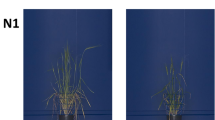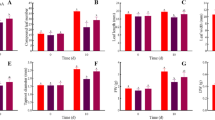Abstract
Datura stramonium leaves fed K15NO3 at 25 μg N ml−1 and 200 μg N ml−1 for 7 and 17 min show that at both time courses the main route of newly reduced nitrogen is to glutamate at the low N-feeding level, and to glutamine at the high N-feeding level. At the high N-feeding level the amido-N of glutamine shows higher15N enrichment than the amino-N, whereas at the low N-feeding level the opposite is true. Feeding of glutamine (15N amido labelled) at the 25 and 200 μg N ml−1 level produces15N enrichment of leaf amino acids, the prime routing being to glutamate. This indicates the operation of glutamate synthase at both feeding levels.
It is possible that inDatura stramonium leaves both the glutamate dehydrogenase and glutamine synthetase/GOGAT pathways are simultaneously operative, the former route being favoured at low N-feeding levels, the latter at high N-feeding levels.
Similar content being viewed by others
References
Gayler, K. R. and Morgan, W. R., An NADP-dependent glutamate dehydrogenase from the green algaCaulerpa simpliciuscula. Plant Physiol.58, 283–287 (1976).
Ito, O and Kumazawa, K., Nitrogen assimilation in sunflower leaves and upward and downward transport of nitrogen. Soil Sci. Plant Nutr.22, 181–189 (1976).
Lea, P. J. and Miflin, B. J., An alternative route for nitrogen assimilation in higher plants. Nature London251, 614–616 (1974).
Lewis, O. A. M., An15N−14C study of the role of the leaf in the nitrogen nutrition of the seed ofDatura stramonium L. J. Exp. Bot.26, 361–366 (1975).
Lewis, O. A. M. and Berry, M. J., Glutamine as a major acceptor of reduced nitrogen in leaves. Planta125, 77–80 (1975).
Lewis, O. A. M. and Pate, J. S., The significance of transpirationally derived nitrogen in protein synthesis in fruiting plants of pea (Pisum sativum L.). J. Exp. Bot.24, 596–606 (1973).
Lorenz, H., Nitrate, ammonium and amino acids in the bleeding sap of tomato plants in relation to form and concentration of nitrogen in the medium. Plant and Soil45, 169–175 (1976).
Miflin, B. J. and Lea, P. J., The pathway of nitrogen assimilation in plants. Phytochemistry15, 873–885 (1976).
Noggle, G. R. and Fritz, G. J., Introductory plant physiology. Prentice Hall, Englewood Cliffs, 277–278 (1976).
Stewart, G. R. and Rhodes, D., Evidence for the assimilation of ammonia via the glutamine pathway in nitrate grownLemna minor L. FEBS Lett.64, 296–299 (1976).
Author information
Authors and Affiliations
Rights and permissions
About this article
Cite this article
Lewis, O.A.M., Probyn, T.A. The effect of nitrate feeding levels on the pathway of nitrogen incorporation into photosynthesizing leaf metabolism ofDatura stramonium L. Plant Soil 49, 625–631 (1978). https://doi.org/10.1007/BF02183286
Received:
Issue Date:
DOI: https://doi.org/10.1007/BF02183286




